After 2+ years of limited travel, and surviving the merciless climate that is Minnesota in February, I recently had the privilege of taking a trip to the Yucatan Peninsula in Mexico.
Not only was the weather sublime and the food exceptional, but the architecture of Mérida (the capital of the State of Yucatan) has left a lasting impression on me, and has inspired me to do more research into the history of this vibrant city.
Founded in 1542 by Spanish conquistadors, Mérida was built on the ruins of the ancient Mayan city of T'ho, whose massive carved stones were repurposed by the Spanish to build their colonial capital. You can still see these stones today, in the monolith walls of the Catedral de San Ildefonso, the oldest cathedral on the North American continent. Despite the apparent simplicity of the interior, in comparison to the typical intricate details of European and later period colonial cathedrals, the beauty of the space and richness of its history was remarkable and undeniable.
At the turn of the 20th century Mérida entered an economic golden age, spurred by a boom in agave production around the city. Because of this, many affluent families built elaborate Spanish and French style mansions along Mérida’s main avenue, the Paseo de Montejo. Most of these mansions have since been refurbished and converted to public buildings and art museums.
Even in the less affluent areas of Mérida, the attention to detail and application of color is captivating. Each block introduced unique colors and intricate wrought-iron gates leading to manicured courtyards adorned with whimsical tile and native flora. Walking through the city was overwhelming at times, overpowering the senses with its vibrancy, and lending a shining example of the intersection of art, architecture, and history.























































































